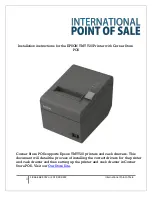
2. Fasten the camera unit to the riser using the 6x threaded bolts
and a suitable thread-locking compound.
D11970-1
• Note the camera forward markings on the camera base.
You must ensure that the camera is facing the correct way
depending upon whether the camera is to be mounted ball-up
or ball-down.
• Ensure the rubber O-ring is positioned correctly in the base
of the camera.
3. Make the required cable connections to the camera tails.
4. Fasten the camera-riser assembly to the mounting surface using
the fasteners supplied.
D11977-1
You must ensure a watertight seal. You may use a marine-grade
sealant as an alternative to the mounting O-ring.
5.2 JCU Mounting
Location requirements
When planning the installation location, consider the following
points:
• Select a position on your vessel that is close to the monitor that
displays the T-Series camera video output.
• Ensure the JCU is mounted at least 55 cm (21.7") away from any
equipment fitted with a magnetic compass.
• The JCU can be mounted to a dash or other surface in any
orientation.
• Consider cable lengths and cable routing.
Flush mounting
The standard method for mounting the JCU is a flush or panel
mounting arrangement.
Before mounting the unit, ensure that you have:
• Selected a suitable location. A clear, flat area with suitable
clearance behind the panel is required.
• Identified the cable connection required and the route that the
cable will take.
• Detached the front bezel to reveal the mounting screws.
Mounting the JCU
1. Cut the mounting hole according to the dimensions specified in
the mounting template included in this document.
2. Ensure that the unit fits into the removed area and then file
around the cut edge until smooth.
3. Drill four 6.4 mm (0.25 in) holes as indicated on the template to
accept the mounting screws.
4. Before mounting the JCU, insert the supplied ethernet cable
through the mounting hole and into the JCU ethernet port.
Ensure the cable gland sealing nut is tightened correctly.
5. Remove the 4 panel mounting clamps and insert the JCU in
place. Affix the mounting clamps to the screws on the other side
of the mounting surface, ensuring that the mounting clamps
are rotated outward from the JCU housing. Tighten the screws
to draw the mounting clamps up against the mounting surface
and then tighten another 1/4 to 1/2 turn. Do not overtighten the
screws.
i.
As shipped from the factory, the JCU can be mounted to a
panel thickness ranging from 0.79 to 4.45 cm (0.31 to 1.750
in). The clamps are set with the small “foot” on the clamp
facing towards the mounting surface, away from the front of
the JCU, as shown in the "Thick panel mounting" diagram
in this document.
ii. To mount the JCU to a panel thickness of 0.79 cm (0.31 in) or
less, remove the clamps from the mounting screws, turn them
around and thread them back onto each of the four screws.
In this configuration, the clamp “foot” faces away from the
mounting surface and allows the clamp to contact thinner
panel surfaces while still allowing for proper compression
of the JCU mounting gasket to form a watertight seal. This
mounting configuration is shown in the "Thin panel mounting"
diagram in this document.
6. Once you have secured the JCU in place, replace the bezel.
Installation
27
Summary of Contents for T303
Page 2: ......
Page 4: ......
Page 6: ...6 T Series...
Page 18: ...18 T Series...
Page 24: ...24 T Series...
Page 28: ...Thin panel mounting D11989 1 Thick panel mounting D11990 1 28 T Series...
Page 40: ...40 T Series...
Page 43: ......
Page 44: ...www raymarine com...
















































